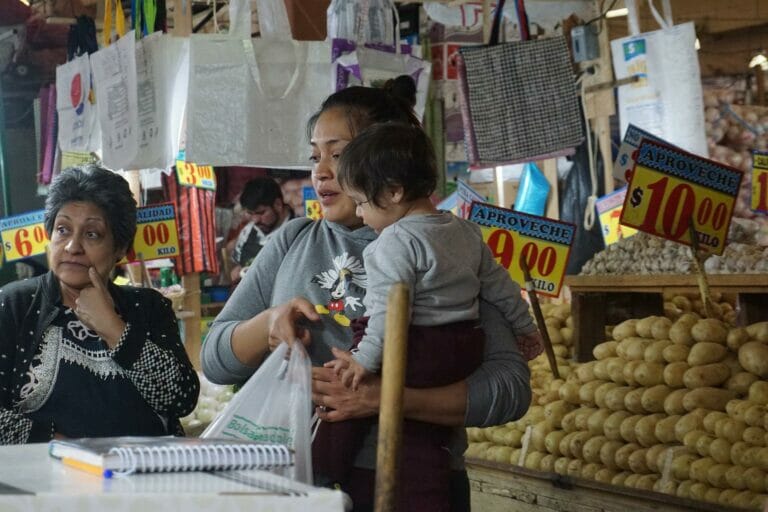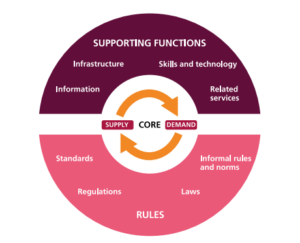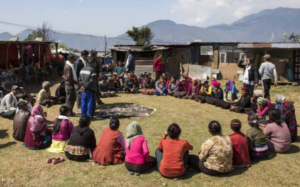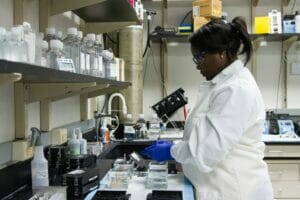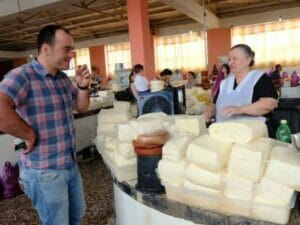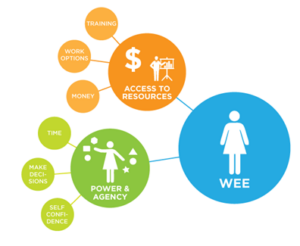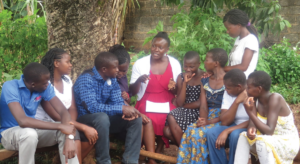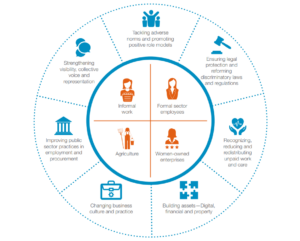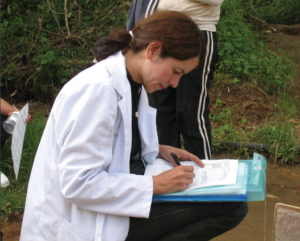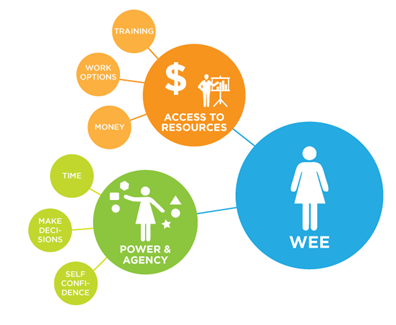
Where should you start?
To successfully and holistically integrate gender in private sector development programmes, a gender lens should be applied to programmes as well as organisations as a whole. From an organisational perspective, it is important that gender and women’s economic empowerment is integrated throughout the organisation by:
Establishing a gender-responsive organisational policy framework
- Design and implement gender-responsive policies on human rights issues that articulate the organisation’s commitments to these issues
- Embed these policies into management systems to ensure that they are implemented as part of regular processes
- Incorporate expectations and policies on human rights, including specific reference to women’s rights, into engagement with partners
Setting organisational gender priorities and integrating with organisational strategy
- Agree on common working definitions of WEE. While definitions vary, increased access and enhanced agency are common to most programme definitions of WEE
- Set a level of ambition and a common vision of change with regards to WEE. This could be to do no harm or to be gender-sensitive, gender positive or gender-transformative
Implementing organisational practices
- Assess and build (management) team capacity on gender; this could be done by building the capacity of current (management) team members or by hiring gender experts
- Set a standard to collecting sex-disaggregated data
To learn more about how to apply a gender lens to specific programmes, click on each of the project cycle steps below:
For an overview:
Identification and gender analysis
The first step in the project cycle is the identification, research and analysis of the current gender and WEE situation. Outcomes of this research should be used to inform project planning and design.
Applying a gender lens to the identification phase of a project primarily means that a thorough gender analysis is undertaken, thus recognising that market systems and the business environment are far from gender-neutral. The gender analysis is the starting point of including WEE in a project or programme. It can be executed as a separate analysis or integrated into other programmes assessments, e.g. the market systems analysis.
The gender analysis aims to assess gender relations and gender inequalities by looking at specific social, economic and political aspects such as gender differences in:
- Access to equitable and safe employment
- Education and training
- Access to and control over economic resources and opportunities
- Voice in society and policy influence
- Freedom from the risk of violence
- Freedom of movement
- Access to and control over health and family formation
- Unpaid care, social protection and childcare
On this basis, the gender analysis should describe any possible differential impact of the programme on women and men, and recommend alternatives to ensure that targeted beneficiaries of all genders can equally access, participate in and benefit from the planned activities.
A gender analysis is only a means and not an end by itself. Its findings, insights and recommendations must be translated into gender-responsive programming.
Examples of key questions that should be considered as part of the gender analysis:
- Are women as well as men (target groups, staff, partners) involved in the initial situation analysis at all levels (e.g. policy dialogue, community consultation)?
- Are organisations working specifically on gender, or with women, consulted?
- What are women’s constraints that are due to rules (formal and informal) in the specific socio-cultural context?
- What are the risks that women – or men – may be harmed? What is the risk for gender-based violence as a result of women’s greater involvement in the market?
Planning and defining indicators
The second step of the project cycle is the setting of objectives and the definition of relevant indicators. This step should be based on the results of the analysis that was done as part of the first step of the project cycle. It considers questions like, what changes do we aim for with our intervention? How do we achieve our targets? How do we measure the results of our intervention? You can apply a gender lens to this step by:
Developing a WEE-specific results chain and strategic framework which can be integrated into the programme’s theory of change
By setting out the causal logic associated with enhancing empowerment, you explain how change occurs in your programme. When it comes to WEE, the causal logic can be different from the logic associated with reducing poverty. For example, we cannot assume that by increasing a women’s income she will automatically become economically empowered. It is therefore important for programmes to articulate parallel causal pathways in the programme-level Theory of Change.
Defining WEE-specific indicators
- When measuring WEE, it is important to consider various spheres of empowerment including access to resources, and power and agency. Access to resources includes indicators like increases in income, skill development and employment opportunities, while agency refers to indicators around time-use, decision making abilities and physical mobility.
- By defining both quantitative and qualitative indicators, you can measure the reach of a programme, and unpack complex issues such as decision-making capabilities. It allows you to further probe and triangulate evidence.
- It is helpful to clarify the unit of analysis for each indicator, whether enterprise, community, household, or individual. Looking at
household change is particularly important at this level because it has a significant impact on a woman’s ability to change her behaviour and interact with markets. - You must develop indicators that are closely linked to their programme objectives to make it possible to assess attribution.
Setting WEE projections and targets
It is useful to set gender participation targets for each intervention. Not only does it help you to understand whether you are reaching the target number of women, but it can also become a tool for negotiating with service providers. Defining economic empowerment objectives means defining a specific target group of women (such as poor women, women business owners, etc.) and a goal for improving their condition in terms of empowerment.
Examples of WEE indicators that could be considered:
- Increase of monthly individual income of men and women beneficiaries
- % of recent household expenditure decisions in which women have participated over a period of time
- Ability to make programmerelevant decisions regarding the purchase, sale, or transfer of assets
- Share between men/women on paid vs unpaid care work
- Perception of importance of women’s additional income to the household due to intervention.
- Perceptions of self-worth and/or confidence
Gender in implementation and monitoring
Once a results chain is formulated, indicators are defined and targets are set, implementation can start. This step includes both the execution and monitoring of project interventions. Gender should be considered in both activities.
Gender in implementation
WEE interventions can be targeted specifically to women, or they can be gender mainstreamed. In the first case, the expected benefits in terms of WEE are likely to be reached by implementing an intervention aiming at the defined and specified target group of women. In the second case, women are targeted as part of a wider target group that includes men. Most programmes include both types of interventions.
Gender in monitoring
In monitoring too, gender can be integrated systematically in the overall project monitoring system, and/or additional gender specific monitoring fields can be defined. There are several key considerations when measuring changes in WEE indicators. These include:
- Regional variations of empowerment. Different indicators may be required in different programme areas to match the local context and experiences of empowerment.
- Women’s education. Research instruments must be tailored to match women’s literacy levels, as in many contexts it can be different from men’s
- Identifying “work”. In contexts where women are mainly engaged in family work as unpaid labour, they may not see themselves as workers or farmers. This can pose challenges for the research team trying to identify the types of work women may be engaged in and whether or not they are beneficiaries of the programme.
- Involving both women and men. It is important to speak directly to women about their empowerment. That said, it is also helpful to speak to men about women’s empowerment. Including questions to gauge men’s perceptions of women’s economic empowerment helps to understand household and workplace gender norms from a man’s perspective.
- Gender-sensitive enumerators. Staff (whether internal or external) should be trained in gender sensitive research practices such as ensuring women survey women in certain contexts.
- Finding ‘empowerment trigger points’. When piloting research instruments it is important to find the right question that can help determine empowerment.
Examples of questions that should be considered as part of Step 3 of the project cycle:
- Are partners and the team gender competent with necessary tools and methodologies?
- Do women and men (target groups, staff, partners) take part in monitoring?
- Do women and men have equitable access and control over programme resources?
- Is gender integrated into the monitoring system, and how?
- Are changes in gender relations reported as part of monitoring?
Gender in evaluation
The fourth step of the project cycle is the evaluation of outputs, results and impacts, for each of the indicators that were defined in step 3. An adequate evaluation provides you with insights into the effectiveness of your programme design and the execution of your interventions. This means that results should tell you something about the validity of your results chain, theory of change and targets.
At the same time, it should help you understand whether programme interventions were successful or not, and why. Key questions on gender need to be integrated into all evaluations taking place (external, or self-evaluations, mid-term and end line).
Attribution
Attribution is a key element to consider in evaluations. It refers to the degree of change that can be credited to an intervention out of the total amount of change that takes place. Measured results are less attributable to a programme’s efforts when external influences are stronger and/or results depend upon a change by one or several intermediaries. The ability of an initiative to attribute changes to its efforts weakens as the changes are further from the original intervention. This is an important consideration when trying to attribute changes in WEE to a programme, particularly at the household level as most PSD programmes do not implement interventions that directly intervene at the household level. Rather, they intervene at the enterprise, service provider or policy levels. Impact level changes, such as household income levels and decision making dynamics, are subject to a greater number of influences. Attributing the expected results at the household level to the programme will therefore require additional exploration to validate.
Feed findings back into the intervention design
Evaluation findings should be used to improve the programme design and intervention execution. When it comes to WEE, getting to the root causes of certain findings could require elaborate further analysis. It is important that gender is considered as a key factor in these analyses.
Examples of questions that should be considered as part of Step 4 of the project cycle:
- What changes do you measure and in what way is it attributable to programme interventions?
- Are there unintended positive or negative effects of the programme on gender?
- Are there new external and contextual factors/actors supporting or impeding gender equality that are relevant for the programme?
- Are women/men supportive of the programme or do they wish to change it?
Gender in reporting
The fifth step is reporting on your findings, which is critical for accountability and learning purposes. It should focus on achieved changes, not only activities, and include the obstacles and challenges in achieving these changes. Translating data and information into a report can help a programme to review its progress and receive feedback and support from senior management. Reporting on gender results has to be integrated systematically in the overall reporting, with a specific focus on using gender-sensitive language. Furthermore, there are additional data protection concerns that should be taken into account.
Ensure anonymity or design a set of procedures that protects data and the identities of beneficiariers
If your programme decides to measure and report on sensitive issues such as household decision-making abilities or gender-based violence, you will need to take necessary precautions to protect data including having data passwords protected and supervised. It is also important to train staff so they understand which information can and cannot be shared.
Endorse strong gender analysis
Many programmes struggle to effectively analyse and report on WEE. It is very common for good research to be misunderstood because the person writing the report had a limited understanding of gender and WEE. To address this, programmes have set up quality control procedures where the Gender Lead and/or Team Leader for the programme complete a gender-sensitivity review before submission.
Examples of questions that should be considered as part of Step 5 of the project cycle:
- Examples of questions that should be considered as part of Step 5 of the project cycle:
- Are best and bad practices on gender mainstreaming analysed and disseminated?
- Has a gender-sensitive feedback mechanism toward the primary target group and key stakeholders been jointly developed and agreed upon?
- Has a communication strategy been developed for informing various publics about the progressand results of the project from a gender perspective?
